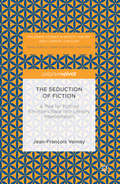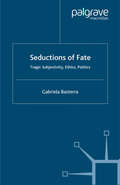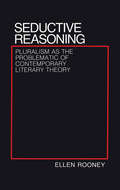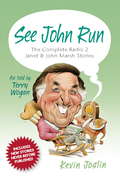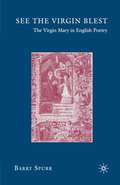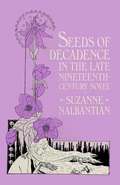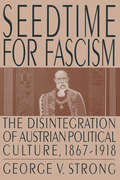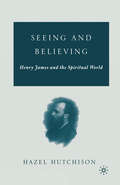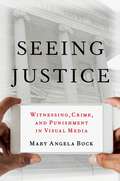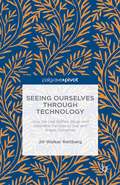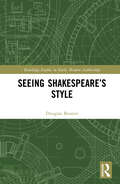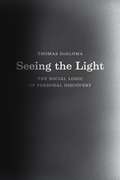- Table View
- List View
Seducing the Eighteenth-Century French Reader: Reading, Writing, and the Question of Pleasure
by Paul J. YoungAs he demonstrates that narratives of seduction function as a master plot for French literature in the eighteenth century, Paul Young argues that the prevalence of this trope was a reaction to a dominant cultural discourse that coded the novel and the new practice of solitary reading as dangerous, seductive practices. Situating his study in the context of paintings, educational manuals, and criticism that caution against the act of reading, Young considers both canonical and lesser-known works by authors that include Rousseau, Sade, Bastide, Laclos, Crébillon fils, and the writers of two widely read libertine novels. How these authors responded to a cultural climate that viewed literature, and especially the novel, as seductive, sheds light on the perils and pleasures of authorship, the ways in which texts interact with the larger cultural discourse, and what eighteenth-century texts tell us about the dangers of reading or writing. Ultimately, Young argues, the seduction not in the text, but by the text raises questions about the nature of pleasure in eighteenth-century French literature and culture.
The Seduction of Fiction: A Plea for Putting Emotions Back into Literary Interpretation (Palgrave Studies in Affect Theory and Literary Criticism)
by Jean-François VernayBy meshing psychology with literary analysis, this book inspires us to view the reading of fictional works as an emotional and seductive affair between reader and writer. Arguing that current teaching practices have contributed to the current decline in the study of literature, Jean-François Vernay’s plea brings a refreshing perspective by seeking new directions and conceptual tools to highlight the value of literature. Interdisciplinary in focus and relevant to timely discussions of the vitality between emotion and literary studies, particularly within the contexts of psychology, affect studies, and cognitive studies, this book will open up a space in which the formation of our emotions can be openly examined and discussed.
Seductions of Fate: Tragic Subjectivity, Ethics, Politics
by G. BasterraIf the tragic interpretation of experience is still so current, despite its disastrous ethical consequences, it is because it shapes our subjectivity. Instead of contradicting the ideals of autonomy and freedom, a modern subjectivity based on self-victimization in effect enables them. By embracing subjection to an alienating other (the Law, Power) the autonomous subject protects its sameness from the disruption of real people. Seductions of Fate stages a dialogue between this tragic agent of political emancipation and the unconditional ethical demands it seeks to evade.
Seductive Forms: Women's Amatory Fiction from 1684 to 1740
by Ros BallasterHistoricist and feminist accounts of the `rise of the novel' have neglected the phenomenon of the professional woman writer in England prior to the advent of the sentimental novel in the 1740s. Seductive Forms explores the means by which the three leading Tory women novelists of the late seventeenth and early eighteenth centuries challenged and reworked both contemporary gender ideologies and generic convention. The seduction plot provided Aphra Behn, Delarivier Manley, and Eliza Haywood with a vehicle for dramatizing their own appropriation of the `masculine' power of fiction-making. Seduction is employed in these fictions as a metaphor for both novelistic production (the seduction of the reader by the writer) and party political machination (the seduction of the public by the politician). This challenging and lively book also explores the debts early prose fiction owed to French seventeenth-century models of fiction-writing and argues that Behn, Manley, and Haywood succeed in producing a distinctively `English' and female `form' for the amatory novel.
Seductive Reasoning: Pluralism as the Problematic of Contemporary Literary Theory
by Ellen RooneySeductive Reasoning takes a provocative look at contemporary Anglo-American literary theory, calling into question the critical consensus on pluralism's nature and its status in literary studies. Drawing on the insights of Marxist and feminist critical theory and on the works of Althusser, Derrida, and Foucault, Rooney reads the pluralist’s invitation to join in a "dialogue" as a seductive gesture. Critics who respond find that they must seek to persuade all of their potential readers. Rooney examines pluralism as a form of logic in the work of E. D. Hirsch, as a form of ethics for Wayne Booth, as a rhetoric of persuasion in the books of Stanley Fish. For Paul de Man, Rooney argues, pluralism was a rhetoric of tropes just as it was, for Fredric Jameson, a form of politics.
See John Run
by Kevin JoslinEight million listeners to BBC Radio 2's Wake Up To Wogan were beguiled and bewitched by the naughty but nice adventures of John and his wife Janet. In the style of children's stories of yesteryear, John gets up to all sorts. Then he tells Janet all about his day, by which time every perfectly innocent big end, back passage and stiff one acquires a whole new meaning... After selling over a quarter of a million recordings of their adventures, they're now available in hard covers for the first time.
See the Virgin Blest: The Virgin Mary in English Poetry
by B. SpurrThis is a fascinating literary-critical study of the ways the Virgin Mary has been presented in English poetry, from the later Middle Ages to today. It includes several focused studies on a particular poet and his/her representation of the Virgin, blending historical, theological and cultural issues with the dominant literary-critical approach.
Seeds of Decadence in the Late Nineteenth-Century Novel: A Crisis in Values
by Suzanne NalbantianA comparative assessment of the transmutation of a decadent mentality into an identifiable narrative style. The author examines the work of five major novelists in the last quarter of the nineteenth century and attempts to trace perplexities, perversities and combinations of excess.
Seedtime for Fascism: Disintegration of Austrian Political Culture, 1867-1918
by George V. StrongThis study examines the political culture in Austria-Hungary in the latter half of the 19th century. It analyzes the centrifugal forces that arose from growing ethnic nationalism in the empire and that ultimately overpowered the centripetal forces which held the Austrian-Hungarian "state idea" together. The analysis is applied further to provide an historical explanation of analogous developments in post-1989 Europe.
Seedtime for Fascism: Disintegration of Austrian Political Culture, 1867-1918
by George V. StrongThis study examines the political culture in Austria-Hungary in the latter half of the 19th century. It analyzes the centrifugal forces that arose from growing ethnic nationalism in the empire and that ultimately overpowered the centripetal forces which held the Austrian-Hungarian "state idea" together. The analysis is applied further to provide an historical explanation of analogous developments in post-1989 Europe.
Seeing and Believing: Henry James and the Spiritual World
by H. HutchisonThis study looks at Henry James's response to the collapse of religious belief in the nineteenth century in his late novels and shorter works. Hutchison's work argues that James's fascination with perception and consciousness should be read in the context of his desire to dramatize a level of human experience beyond the material.
Seeing Double: Baudelaire's Modernity
by Françoise MeltzerThe poet Charles Baudelaire (1821–1867) has been labeled the very icon of modernity, the scribe of the modern city, and an observer of an emerging capitalist culture. Seeing Double reconsiders this iconic literary figure and his fraught relationship with the nineteenth-century world by examining the way in which he viewed the increasing dominance of modern life. In doing so, it revises some of our most common assumptions about the unresolved tensions that emerged in Baudelaire’s writing during a time of political and social upheaval. Françoise Meltzer argues that Baudelaire did not simply describe the contradictions of modernity; instead, his work embodied and recorded them, leaving them unresolved and often less than comprehensible. Baudelaire’s penchant for looking simultaneously backward to an idealized past and forward to an anxious future, while suspending the tension between them, is part of what Meltzer calls his “double vision”—a way of seeing that produces encounters that are doomed to fail, poems that can’t advance, and communications that always seem to falter. In looking again at the poet and his work, Seeing Double helps to us to understand the prodigious transformations at stake in the writing of modern life.
Seeing Double: Baudelaire's Modernity
by Françoise MeltzerThe poet Charles Baudelaire (1821–1867) has been labeled the very icon of modernity, the scribe of the modern city, and an observer of an emerging capitalist culture. Seeing Double reconsiders this iconic literary figure and his fraught relationship with the nineteenth-century world by examining the way in which he viewed the increasing dominance of modern life. In doing so, it revises some of our most common assumptions about the unresolved tensions that emerged in Baudelaire’s writing during a time of political and social upheaval. Françoise Meltzer argues that Baudelaire did not simply describe the contradictions of modernity; instead, his work embodied and recorded them, leaving them unresolved and often less than comprehensible. Baudelaire’s penchant for looking simultaneously backward to an idealized past and forward to an anxious future, while suspending the tension between them, is part of what Meltzer calls his “double vision”—a way of seeing that produces encounters that are doomed to fail, poems that can’t advance, and communications that always seem to falter. In looking again at the poet and his work, Seeing Double helps to us to understand the prodigious transformations at stake in the writing of modern life.
Seeing Double: Baudelaire's Modernity
by Françoise MeltzerThe poet Charles Baudelaire (1821–1867) has been labeled the very icon of modernity, the scribe of the modern city, and an observer of an emerging capitalist culture. Seeing Double reconsiders this iconic literary figure and his fraught relationship with the nineteenth-century world by examining the way in which he viewed the increasing dominance of modern life. In doing so, it revises some of our most common assumptions about the unresolved tensions that emerged in Baudelaire’s writing during a time of political and social upheaval. Françoise Meltzer argues that Baudelaire did not simply describe the contradictions of modernity; instead, his work embodied and recorded them, leaving them unresolved and often less than comprehensible. Baudelaire’s penchant for looking simultaneously backward to an idealized past and forward to an anxious future, while suspending the tension between them, is part of what Meltzer calls his “double vision”—a way of seeing that produces encounters that are doomed to fail, poems that can’t advance, and communications that always seem to falter. In looking again at the poet and his work, Seeing Double helps to us to understand the prodigious transformations at stake in the writing of modern life.
Seeing Double: Baudelaire's Modernity
by Françoise MeltzerThe poet Charles Baudelaire (1821–1867) has been labeled the very icon of modernity, the scribe of the modern city, and an observer of an emerging capitalist culture. Seeing Double reconsiders this iconic literary figure and his fraught relationship with the nineteenth-century world by examining the way in which he viewed the increasing dominance of modern life. In doing so, it revises some of our most common assumptions about the unresolved tensions that emerged in Baudelaire’s writing during a time of political and social upheaval. Françoise Meltzer argues that Baudelaire did not simply describe the contradictions of modernity; instead, his work embodied and recorded them, leaving them unresolved and often less than comprehensible. Baudelaire’s penchant for looking simultaneously backward to an idealized past and forward to an anxious future, while suspending the tension between them, is part of what Meltzer calls his “double vision”—a way of seeing that produces encounters that are doomed to fail, poems that can’t advance, and communications that always seem to falter. In looking again at the poet and his work, Seeing Double helps to us to understand the prodigious transformations at stake in the writing of modern life.
Seeing Justice: Witnessing, Crime and Punishment in Visual Media
by Mary Angela BockA behind-the-scenes look at the struggles between visual journalists and officials over what the public sees--and therefore much of what the public knows--of the criminal justice system. In the contexts of crime, social justice, and the law, nothing in visual media is as it seems. In today's mediated social world, visual communication has shifted to a democratic sphere that has significantly changed the way we understand and use images as evidence. In Seeing Justice, Mary Angela Bock examines the way criminal justice in the US is presented in visual media by focusing on the grounded practices of visual journalists in relationship with law enforcement. Drawing upon extended interviews, participant observation, contemporary court cases, and critical discourse analysis, Bock provides a detailed examination of the way digitization is altering the relationships between media, consumers, and the criminal justice system. From tabloid coverage of the last public hanging in the US to Karen-shaming videos, from mug shots to perp walks, she focuses on the practical struggles between journalists, police, and court officials to control the way images influence their resulting narratives. Revealing the way powerful interests shape what the public sees, Seeing Justice offers a model for understanding how images are used in news narrative.
Seeing Justice: Witnessing, Crime and Punishment in Visual Media
by Mary Angela BockA behind-the-scenes look at the struggles between visual journalists and officials over what the public sees--and therefore much of what the public knows--of the criminal justice system. In the contexts of crime, social justice, and the law, nothing in visual media is as it seems. In today's mediated social world, visual communication has shifted to a democratic sphere that has significantly changed the way we understand and use images as evidence. In Seeing Justice, Mary Angela Bock examines the way criminal justice in the US is presented in visual media by focusing on the grounded practices of visual journalists in relationship with law enforcement. Drawing upon extended interviews, participant observation, contemporary court cases, and critical discourse analysis, Bock provides a detailed examination of the way digitization is altering the relationships between media, consumers, and the criminal justice system. From tabloid coverage of the last public hanging in the US to Karen-shaming videos, from mug shots to perp walks, she focuses on the practical struggles between journalists, police, and court officials to control the way images influence their resulting narratives. Revealing the way powerful interests shape what the public sees, Seeing Justice offers a model for understanding how images are used in news narrative.
Seeing Ourselves Through Technology: How We Use Selfies, Blogs and Wearable Devices to See and Shape Ourselves
by Jill W. RettbergThis book is open access under a CC BY license. Selfies, blogs and lifelogging devices help us understand ourselves, building on long histories of written, visual and quantitative modes of self-representations. This book uses examples to explore the balance between using technology to see ourselves and allowing our machines to tell us who we are.
Seeing Shakespeare’s Style (Routledge Studies in Early Modern Authorship)
by Douglas BrusterSeeing Shakespeare’s Style offers new ways for readers to perceive Shakespeare and, by extension, literary texts generally. Organized as a series of studies of Shakespeare’s plays and poems, poetry and prose, it looks at the inner functioning of language and form in works from all phases of this writer’s career. Because the very concept of literary style has dropped out of so many of our conversations about writing, we need new ways to understand how words, phrases, speeches, and genres in literature work. Responding to this need, this book shows how visual representations of writing can lead to a deeper understanding of language’s textures and effects. Beginning with chapters that a beginning reader of Shakespeare can benefit from, its second half puts these tools to use in more in-depth examinations of Shakespeare’s language and style. Although focused on Shakespeare’s works, and the works of his contemporaries, this book provides tools for all readers of literature by defining style as material, graphic, and shaped by the various media in which all writers work.
Seeing Shakespeare’s Style (Routledge Studies in Early Modern Authorship)
by Douglas BrusterSeeing Shakespeare’s Style offers new ways for readers to perceive Shakespeare and, by extension, literary texts generally. Organized as a series of studies of Shakespeare’s plays and poems, poetry and prose, it looks at the inner functioning of language and form in works from all phases of this writer’s career. Because the very concept of literary style has dropped out of so many of our conversations about writing, we need new ways to understand how words, phrases, speeches, and genres in literature work. Responding to this need, this book shows how visual representations of writing can lead to a deeper understanding of language’s textures and effects. Beginning with chapters that a beginning reader of Shakespeare can benefit from, its second half puts these tools to use in more in-depth examinations of Shakespeare’s language and style. Although focused on Shakespeare’s works, and the works of his contemporaries, this book provides tools for all readers of literature by defining style as material, graphic, and shaped by the various media in which all writers work.
Seeing Suffering in Women's Literature of the Romantic Era
by Elizabeth A. DolanArguing that vision was the dominant mode for understanding suffering in the Romantic era, Elizabeth A. Dolan shows that Mary Wollstonecraft, Charlotte Smith, and Mary Shelley experimented with aesthetic and scientific visual methods in order to expose the social structures underlying suffering. Dolan's exploration of illness, healing, and social justice in the writings of these three authors depends on two major questions: How do women writers' innovations in literary form make visible previously unseen suffering? And, how do women authors portray embodied vision to claim literary authority? Dolan's research encompasses a wide range of primary sources in science and medicine, including nosology, health travel, botany, and ophthalmology, allowing her to map the resonances and disjunctions between medical theory and literature. This in turn points towards a revisioning of enduring themes in Romanticism such as the figure of the Romantic poet, the relationship between the mind and nature, sensibility and sympathy, solitude and sociability, landscape aesthetics, the reform novel, and Romantic-era science. Dolan's book is distinguished by its deep engagement with several disciplines and genres, making it a key text for understanding Romanticism, the history of medicine, and the position of the woman writer during the period.
Seeing Suffering in Women's Literature of the Romantic Era
by Elizabeth A. DolanArguing that vision was the dominant mode for understanding suffering in the Romantic era, Elizabeth A. Dolan shows that Mary Wollstonecraft, Charlotte Smith, and Mary Shelley experimented with aesthetic and scientific visual methods in order to expose the social structures underlying suffering. Dolan's exploration of illness, healing, and social justice in the writings of these three authors depends on two major questions: How do women writers' innovations in literary form make visible previously unseen suffering? And, how do women authors portray embodied vision to claim literary authority? Dolan's research encompasses a wide range of primary sources in science and medicine, including nosology, health travel, botany, and ophthalmology, allowing her to map the resonances and disjunctions between medical theory and literature. This in turn points towards a revisioning of enduring themes in Romanticism such as the figure of the Romantic poet, the relationship between the mind and nature, sensibility and sympathy, solitude and sociability, landscape aesthetics, the reform novel, and Romantic-era science. Dolan's book is distinguished by its deep engagement with several disciplines and genres, making it a key text for understanding Romanticism, the history of medicine, and the position of the woman writer during the period.
Seeing the Light: The Social Logic of Personal Discovery
by Thomas DeGlomaThe chorus of the Christian hymn “Amazing Grace” reads, “I once was lost, but now am found, / Was blind but now I see.” Composed by a minister who formerly worked as a slave trader, the song expresses his experience of divine intervention that ultimately caused him to see the error of his ways. This theme of personal awakening is a feature of countless stories throughout history, where the “lost” and the “blind” are saved from darkness and despair by suddenly seeing the light. In Seeing the Light, Thomas DeGloma explores such accounts of personal awakening, in stories that range from the discovery of a religious truth to remembering a childhood trauma to embracing a new sexual orientation. He reveals a common social pattern: When people discover a life-changing truth, they typically ally with a new community. Individuals then use these autobiographical stories to shape their stances on highly controversial issues such as childhood abuse, war and patriotism, political ideology, human sexuality, and religion. Thus, while such stories are seemingly very personal, they also have a distinctly social nature. Tracing a wide variety of narratives through nearly three thousand years of history, Seeing the Light uncovers the common threads of such stories and reveals the crucial, little-recognized social logic of personal discovery.
Seeing the Light: The Social Logic of Personal Discovery
by Thomas DeGlomaThe chorus of the Christian hymn “Amazing Grace” reads, “I once was lost, but now am found, / Was blind but now I see.” Composed by a minister who formerly worked as a slave trader, the song expresses his experience of divine intervention that ultimately caused him to see the error of his ways. This theme of personal awakening is a feature of countless stories throughout history, where the “lost” and the “blind” are saved from darkness and despair by suddenly seeing the light. In Seeing the Light, Thomas DeGloma explores such accounts of personal awakening, in stories that range from the discovery of a religious truth to remembering a childhood trauma to embracing a new sexual orientation. He reveals a common social pattern: When people discover a life-changing truth, they typically ally with a new community. Individuals then use these autobiographical stories to shape their stances on highly controversial issues such as childhood abuse, war and patriotism, political ideology, human sexuality, and religion. Thus, while such stories are seemingly very personal, they also have a distinctly social nature. Tracing a wide variety of narratives through nearly three thousand years of history, Seeing the Light uncovers the common threads of such stories and reveals the crucial, little-recognized social logic of personal discovery.
Seeing the Light: The Social Logic of Personal Discovery
by Thomas DeGlomaThe chorus of the Christian hymn “Amazing Grace” reads, “I once was lost, but now am found, / Was blind but now I see.” Composed by a minister who formerly worked as a slave trader, the song expresses his experience of divine intervention that ultimately caused him to see the error of his ways. This theme of personal awakening is a feature of countless stories throughout history, where the “lost” and the “blind” are saved from darkness and despair by suddenly seeing the light. In Seeing the Light, Thomas DeGloma explores such accounts of personal awakening, in stories that range from the discovery of a religious truth to remembering a childhood trauma to embracing a new sexual orientation. He reveals a common social pattern: When people discover a life-changing truth, they typically ally with a new community. Individuals then use these autobiographical stories to shape their stances on highly controversial issues such as childhood abuse, war and patriotism, political ideology, human sexuality, and religion. Thus, while such stories are seemingly very personal, they also have a distinctly social nature. Tracing a wide variety of narratives through nearly three thousand years of history, Seeing the Light uncovers the common threads of such stories and reveals the crucial, little-recognized social logic of personal discovery.

